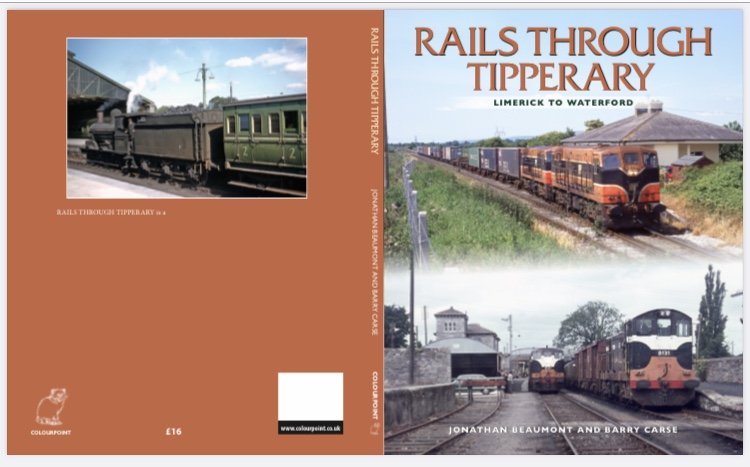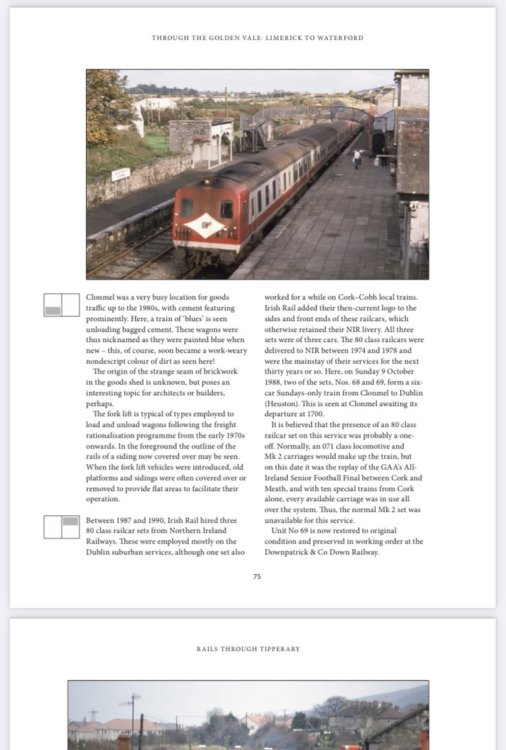-
Posts
15,851 -
Joined
-
Last visited
-
Days Won
393
Content Type
Profiles
Forums
Events
Gallery
Everything posted by jhb171achill
-
Very! Pity about the yokes either side of it!
-
If I ever see a "breathtakingly beautiful" 29, I will certainly write about it! None of the ones I saw today passing my house were endowed with particularly inspiring aesthetics..... As for the ICRs, I will do an article about them if I can find a photo of a fireman shovelling coal into one.......
-
Many thanks, Joe. If I cannot achieve the high modelling standards of many here, at least I can attempt to put on paper some material which might be of use to modellers present and future!
-
I had actually seriously considered doing Mallow - Waterford, and Barry and I considered including it in the above. However, lack of suitable or available colour material would have made it unsuitable for this book, and it's been covered in other "serious" histories. It is indeed a line that I would like to turn my attention to at some stage, though, but perhaps more suitable for a 2 or 3 part article in the IRRS Journal. Waterford to Rosslare will feature, though, in something else I'm working on. I'm hoping that "R T Tipperary" will be on sale for the Christmas market. It covers the triangle of Limerick to Waterford, Clonmel - Thurles, Thurles Sugar factory and Thurles - Limerick Junction, as well as the highly scenic Nenagh Branch. Killaloe and Cashel get in there too. Barry and I are working on a 4th album at the moment, the details of which I will post once there's anything coherent TO post!
-
Auction of railway memorabilia amd model trains
jhb171achill commented on flange lubricator's event in Community Calendar
It's obvious that Purcell's don't really know what they're dealing with.....! -
Hot off the press - preview of what kept Barry and myself busy last winter…. This is the publisher’s preview for BC and myself to approve before it goes to the printers. ....and yes, we're working on another. Keyboard in action tonight.
-
Yes, they were fitted. I actually had one of ‘em at one stage. It wasn’t so much an issue of “getting them again”; it was more a case of this one missing. They kept the “stuck-on” ones from silver through to green, but they were removed once they were repainted black. This particular loco, for some reason, is at the time of the photo bereft of its badge, just like some steam locomotive tenders remained plain grey with no flying snail.
-
Noticing that in the silver livery it doesn't have one of the snails..... in the Limerick Junction shot, he must have about twelve bogies on plus the tin van... the leading carriage is a pre-1910 GSWR one. Isn't it great to see a stone wall which is not (a) covered in graffiti by brainless morons, and (b) with weeds growing out of it and ivy covering it. People in this day and age haven't the first clue about how much damage weeds do to masonry....but that's another story.
-
If they're superglued, you'd have job getting them off! If it's awkward, paint over them. In reality, if you look at photos of coaches in the 1955-63 green livery, nothing close to all of them had any "snails" at all; I guess perhaps 40% didn't, so a lack of a "snail" is quite authentic. Same with steam locos, by the way; many tenders were just plain grey. I've seen a picture of at least one green tender too with no "snail", though its possible the transfer (unlike yours!) had come off or worn off........
-
Wexford Model Railway Club Festival Open Day 2021
jhb171achill replied to Irishrailwayman's topic in What's On?
Might I echo that this is excellent news!- 98 replies
-
- 3
-

-
- model railway exhibition
- trade stands
- (and 3 more)
-
Shunting layouts - which is as far as I’ve got - need a good lot of rolling stock in order to avoid repetitiveness. Here, Fair Day at Dugort Harbour will require a separate goods train today following the passenger local. The wagons are all over the place, but the passenger train will go first; there’s the Cork connection to meet. A point to make; not for the first time I commend Provincial Wagons for their typical wagons of the era - the Bullied opens, cattle wagons and "H" goods vans.
-
This is what always strikes me when Barry Carse and I are going through his photos taken in the 1970-2000 period - the sheer variety of goods trains all over the place. Where were Eamon Ryan and his green environmental friends back then?
-
Yes, CIE used the EDN initially on wagon numerals and painted-on "snails", but white seems to have replaced this in the early 50s. There were a few antique wagons still carrying it in West Cork, and on the Cavan & Leitrim, in the late 50s / early 60s. White lining and snails, as used by Silverfox, is quite simply wrong - but as mentioned above a bit of careful weathering will sort it out - sometimes it faded; on one of the two Arigna branch brake composites you'd swear the line above the windows WAS white due to the dreadful state of fading in the paint, towards the end. And yes, matching your C is by far the best option - or that picture you posted above of a clean Rosslare dining car in Cork shows it better - and cleaner.
-
In terms of RTR, not a big lot that wasn't there when you were here before, though IRM have several modern-image wagons since. Naturally, we're all keenly awaiting the A class locos this week! Provincial wagons brought out a CIE cattle truck and "H" van as kits in comparatively recent times, and Murphy Models had the 121 class diesels. Can't think of others....
-
I follow the modelling scenes in Indonesia, South Africa and Brazil, and to an extent India, and despite the sizes of those countries, with almost no exceptions, the standards are nowhere remotely close to those achieved by IRM / Accurascale. Not even in the same galaxy. The solitary exception is the superb, but very expensive, models made of South African locomotives by one solitary "one-man-band" manufacturer. And he would equal - but not exceed - IRM / A'scale.
-
Well done and well deserved.
-
The green you have on your "C" behind is the same green the coach would be if you want mid to late 50s - so just match that, and don't forget to weather it within an inch of its life! Ends and roof black (weathered black!), not grey. In late 50s livery, a single thin pale green line at waist level. And in that livery some carriages had "flying snail" logos, but many (possibly a good half of them) had none. If you want the earlier livery, it's a darker "leaf green". By the late 50s it had almost disappeared, except in West Cork! That will have a broader waistline, plus a much thicker one above window level, plus "snails". There's a third "localised" Cork variation. In Albert Quay, several old bogies were painted in the older dark green, with "snails" but with no lining at all. So there are three variations, with both shades of green represented. There were just two greens (see my last post); the above being a very new and clean version of the 1955-62 one. The transfers for the "snails" are the same on both, and the light green lining is the same colour on both, but wider on the dark green version (1945-55). Beware of white or yellow (or even gold!) transfers for CIE coaches which some manufacturers persist in offering; these are plain wrong in all circumstances, like a purple one would be! No green coach ever had lining or snails in anything but this watery light green, called "eau-de-nil". Pre-1955, many wagon "snails" were also in this colour, rather than white.... but that's another story, of course!
-
Good to see you back, Tony!
.png.c363cdf5c3fb7955cd92a55eb6dbbae0.png)






